This plant is 2.000 years old. Extraordinary reportage on a living fossil of the Namibian desert. It was inventing the flower. It has only two leaves, which grow continuously fraying on the red-hot desert soil. The marriage maker insects. Incredible cunning to survive.
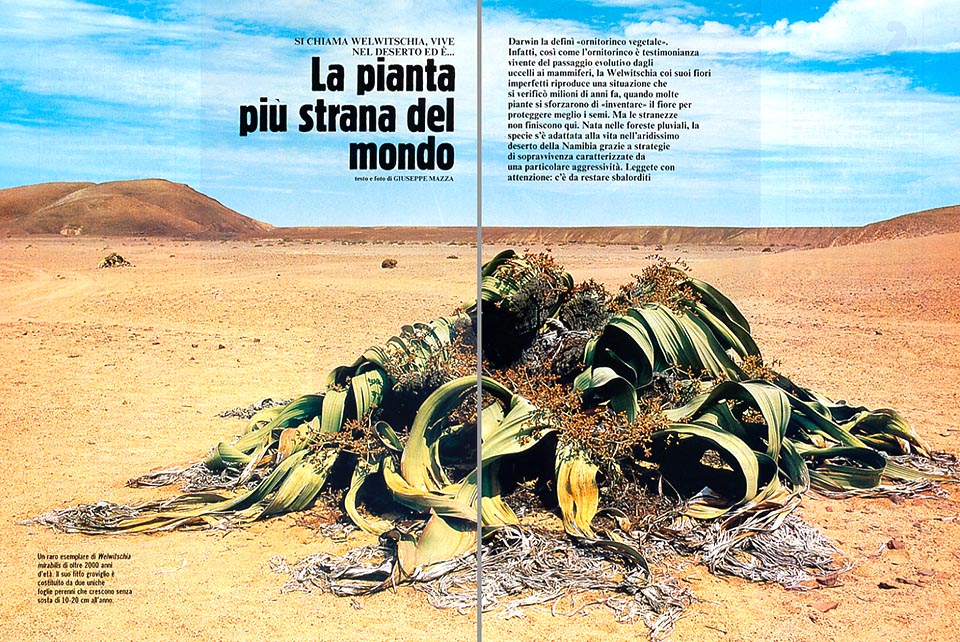
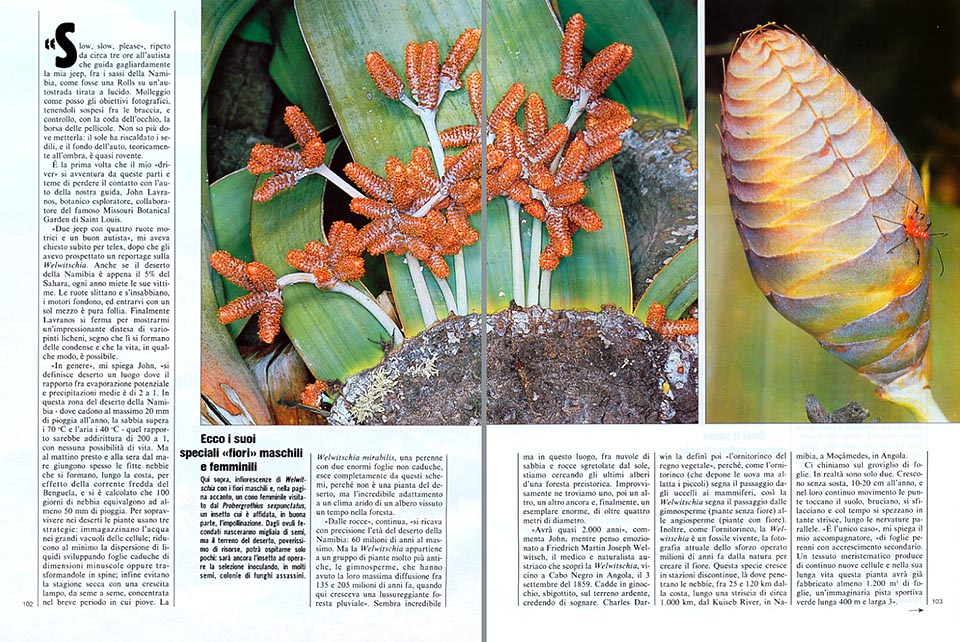

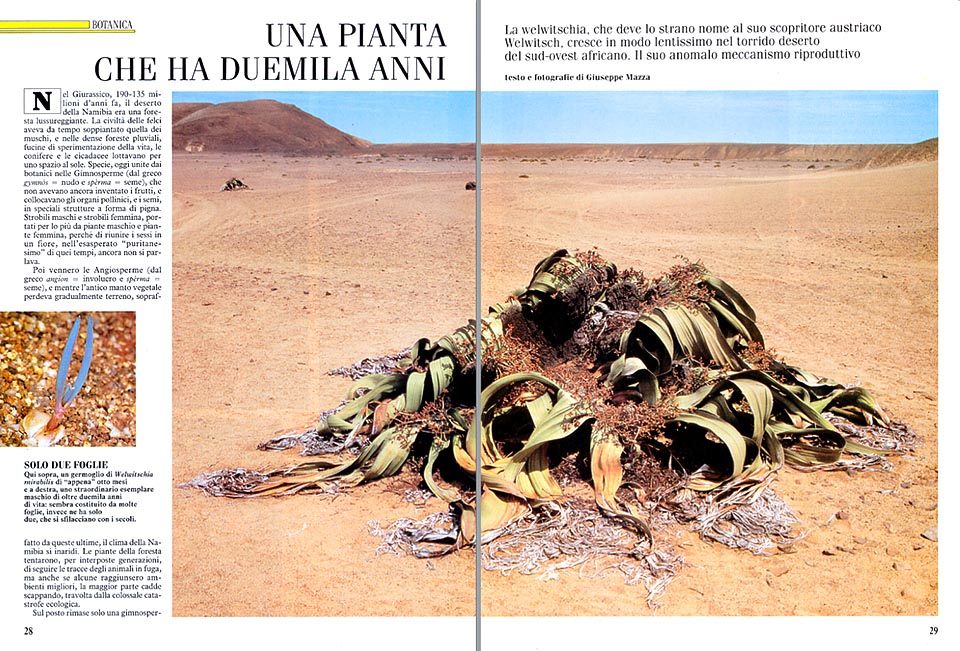
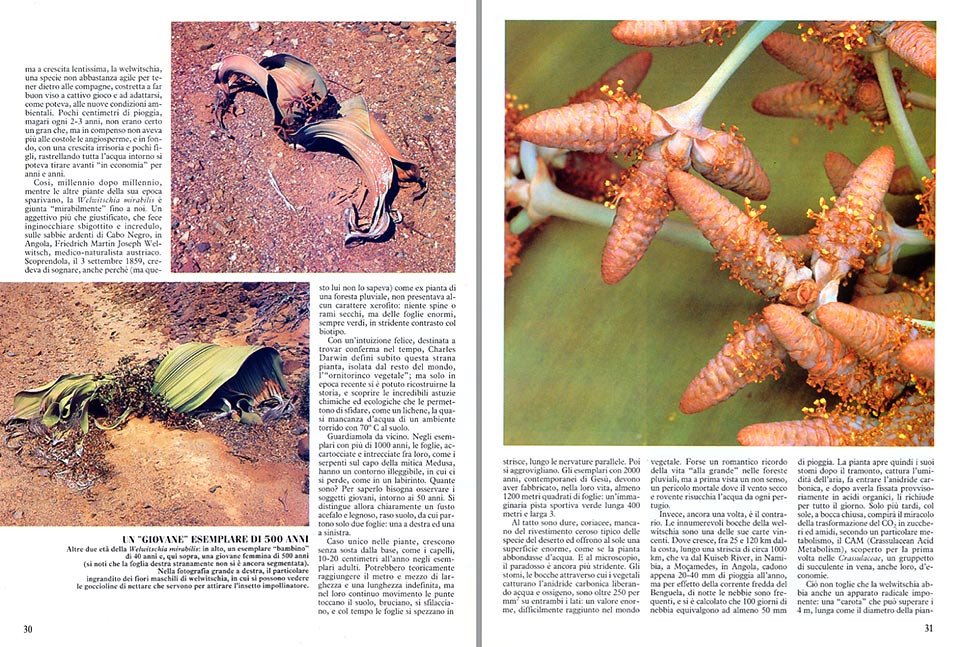
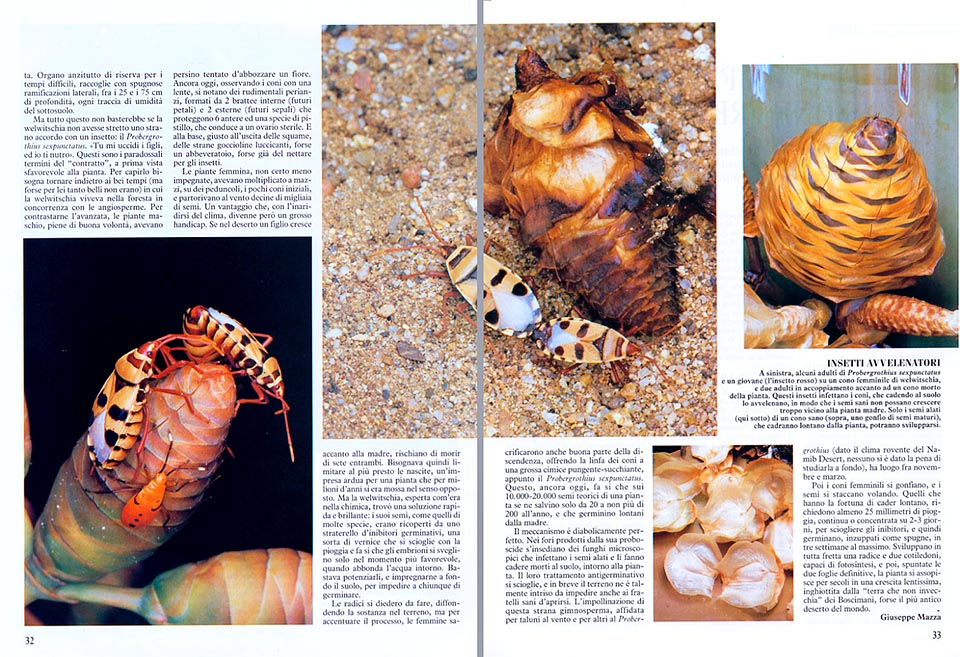
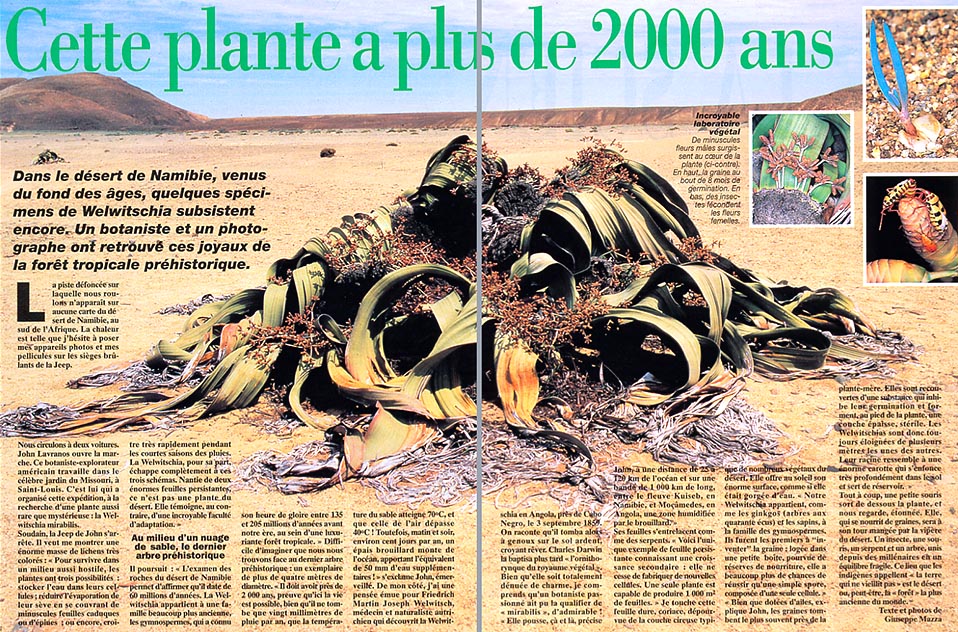

Texto © Giuseppe Mazza

English translation by Mario Beltramini
“Slow, slow, please!”, I repeat, since three hours, to the chauffeur who drives vigorously my jeep, between the rocks of Namibia, like a Rolls on a glossy motorway.
It is not a request any more, but something halfway between a supplication and the need to relieve, at each jerk, my conscience from the possible damages to my cameras.
I balance, as I can, the lenses, keeping them suspended between my arms, and I check, out of the corner of my eye, the bag of the exposed films and of “quick usage”. I do not know any more where to place it: the sun has already warmed up all the seats, and the back of the car, theoretically in the shade, is almost red-hot for the friction.
The coolest place is in the centre, about 20 cm under the roof, and there, with difficulty, I hook my bag, with the sadistic gratification to see it banging against the head of my “driver”, at each time that he exaggerates or negotiates badly the road.
The poor thing is driving for the first time in this area: he regrets, since two days, the “adventurous” tourists who content themselves with the watering of Etosha, and is afraid to lose contact with the car of our guide, John Lavranos, botanical explorer, collaborator of the famous Missouri Botanical Garden of St. Louis.
“Two four-wheels drive jeeps and a good driver”, he had asked me, at once, by telex, as soon as I had advanced the idea of a report on the Welwitschia.
Even if the desert of Namibia is only the 5% of the Sahara, every year it makes its victims. The wheels skid and get caught by the sand, the motors melt, and entering it, alone, with only one car, is pure madness. Our trail is not even shown on the maps, and if we could not see the white cloud of dust of John’s car, often we would not know where to go.
At last, he stops, and shows me an impressive extent of many coloured lichens, which means that some condensations take place there, and that the life is somewhat possible. From under a rock, a small plant comes out, similar to a cactus. It grows up taking advantage of a couple of hours of shade and of the dew which slides on the rock.
Normally, he explains me, it’s called desert a place where the potential evaporation is the double of the average precipitations. Here, there is a maximum fall of 20 mm per year, the sand overcomes the 70 °C, the air the 40 °C, and the ratio should be of 1 to 200, with no possibility of life.
But, early in the morning and in the evening, often thick fogs do come from the sea, which form, along the coastline, due to the effect of the cold stream of Benguela, and they have calculated that 100 days of fog are equivalent to at least 50 mm of rain.
For surviving in the desert, the plants utilize three strategies: they store the water in the great vacuoles of the cells, like this succulent, reduce the waste of liquids with deciduous leaves, tiny, or transformed in thorns, or avoid the dry season with a very fast growth, from seed to seed, concentrated in the short period of rain.
The Welwitschia mirabilis, a perennial with two non-deciduous huge leaves, gets out completely from these fixed patterns, as it is not a desert plant, but the incredible adaptation of a forest tree to an arid climate.
I look at him, puzzled.
From the rocks, he goes on, we learn with accuracy the age of the Namib Desert, 60 millions of years, at the most, and the Welwitschia belongs to a group of plants much older, the gymnospermae, which had their maximum expansion 135-205 millions of years ago, when here there was growing, luxuriant, a pluvial forest.
It is incredible to think at this, between clouds of sand and rocks crumbled by the sun, but, in conclusion, we are looking for the last trees of a prehistoric forest.
Suddenly, we find one of them, then another one, one more, and, finally, an enormous specimen, with more than four metres of diameter.
It must be about 2.000 years old, John comments, while I think, moved, to Friedrich Martin Joseph Welwitsch, the Austrian doctor and naturalist, who discovered the Welwitschia, close to Cabo Negro, in Angola, on Sept. 3rd, 1859.
He kneeled down, astonished, on the burning ground, thinking to be in a dream. Charles Darwin defined it as the “duckbill of the vegetable kingdom”, and I understand immediately how the deficiency of aesthetic attractions is, for a botanist, trifling, and the appellation “mirabilis”, is more than justified.
It grows up in discontinuous sites, John continues, where the fogs come, between 25 km and 120 km from the coast, along a strip of about 1.000 km, which goes from the Kuiseb River, in Namibia, to Moçamedes, in Angola.
We bend on the knot of the leaves, scorched at the apex, where they intertwine like the serpents on the head of the mythical Medusa.
As a matter of fact, they are only two.
They grow without respite, 10-20 cm per year, like hair from an acephalous trunk. Theoretically, they might reach the metre and a half of length, and an indefinite breadth, but, in their continuous movement, the points touch the soil, burn out, fray and, time passing, the leaves break in many stripes, along the parallel nervations.
It is the only case, he explains me, of perennial leaves with a secondary increase. A meristematic tissue produces, continuously, new cells and in its long life, this plant has already fabricated at least 1.000 square metres of leaves, an imaginary green sport track, 400 metres long, and three wide.
I touch them: they are hard, leathery, and do not have the waxy coating typical of many plants of the desert, and offer to the sun an enormous surface, like if the plants should abound in water.
They must have very few stomata, I comment, thinking to the losses connected with the photosynthesis in the desert.
On the contrary, they are more than 250 per square mm, on both sides, more than most of the plants. A souvenir, maybe, of the “grand” life, passed, millions of years ago in the rainy forests.
All right, but, now?
The more numerous the “mouths” are, he explains me, the better they absorb the morning dews. Then, during the day, when the air becomes warm and dry, they often close and the Welwitschia adopts a particular metabolism, the CAM (Crassulacean Acid Metabolism), discovered, for the first time, in a group of succulent plants, the Crassulaceae.
It opens the stomata only during the night, or by dawn, when it’s cool and the carbon dioxide can enter without allowing the wind and the warmth to carry away too much water, fixes temporarily the CO2 in organic acids, and transforms it, later on, with the sun, in sugars and starches.
A surprisingly evolved metabolism in a species, in many ways, prehistoric.
From a systematic point of view, John continues, the Weltwischia mirabilis is a gymnosperm, that is, a plant with “naked seeds”, relative to the cycadaceae (plants resembling to small palms, cultivated also in our country, in Riviera), to the ginkgo and to the well known conifers.
By the time of their appearance, the ferns had already invented the vascular system cells for transporting the water from the soil to the leaves, but the reproduction was still entrusted to the humidity of the forest and to the spores.
The gymnosperms were the first to invent the seed, a sort of “canned small plants”, with nourishing reserves, and many more possibilities of success than an unicellular body, like a spore. Maybe, at the beginning, the seeds were coming out under the leaves, but, later on, these transformed in scales, which the gymnosperms skilfully put in order, one over the other, in pine shaped structures.
Then, the flower plants came, the angiosperms, which, for protecting the seeds and propagate them better, invented the ovary and the fruit. The Welwitschia, still a gymnosperm for the systematics, marks the point of passage between these two groups of plants.
He shows me the microscopic masculine flowers (like in the cycadaceae and in many primitive species the sexes are separated: the plants, called dioecious, present, that is, only masculine or feminine organs): they come out from scales of small “pines”, carried by short peduncles.
They have already a rudimentary perianth, he explains to me, made by two internal bracts (future petals), and two outer ones (future sepals), which protect six anthers and a sort of a pistil, which leads to a sterile ovary. A real flower, then, even if only sketched.
It is impossible to say if it was the first, by sure, the other plants which tried, now are extinct, and the Welwitschia is the only living witness of that historical step.
At the base of the peduncles, where they come out from the scales, we notice some odd minute drops, of which nobody has ever written on the books. Maybe water, or nectar to attract the insects.
Even if, for some authors, the pollination is entrusted to the wind, John continues, practically there is an insect which takes care of it, the Probergrothius sexpunctatus, which lives, almost in symbiosis, with the Welwitschia.
It spend most of its life sucking the feminine cones, and favouring their infection by microscopic fungi, contributes in doing in such a way that instead of the theoretic 10.000-20.000 seeds per each plant, only 20-200, per year, can survive.
But how? I interrupt him, curious, where stands the benefit?
Although if winged, he explains, the seeds of the Welwitschia normally do not go too far: they bump against the tangle of leaves, and fall down, close to the trunk.
But in the deserts, where the resources are scanty, the young plants cannot allow themselves to compete with the mother: that is, they must grow up, at least, at a certain distance. In order to be sure of not remaining without water in the middle of their development, the seeds are covered by powerful germinative inhibitors (to remove them, are necessary at least 25 mm of rain, continuous, or concentrated into 2-3 days), and the Probergrothius sexpunctatus, causing their death and their fall, acts in such a way that they melt, almost all, at the base of the plant. In short time, the surrounding ground is drenched with anti-germinative substances, and the birth of competitors is impossible.
The fact is that the nearest Welwitschia are several metres far, and it seems that also the huge, carrot-like, roots introduce into the soil poisonous substances. As much deep as the breadth of the plant, they have an important function of reserve, and absorb, with spongy lateral ramifications, between the 25 and the 75 cm of depth, the water which filters underground.
The pollination, John continues, takes place between November and March. Then, the feminine cones swell, the scales rise, and the seeds are scattered away by the wind. Rich in proteins and carbohydrates, extremely hygroscopic, they can wait even three years, and, when the conditions permit, they germinate in 10-20 days.
They develop quickly one root and two cotyledons, capable of effecting the photosynthesis, which will be overcome in size, during the fourth month, by the final leaves.
Suddenly, from a plant, gets out a small mouse: it looks at us, amazed, fro a moment, and goes then back to its small green universe. It feeds on the seeds of the Welwitschia, and is, practically, the only prey of the viper of the desert.
An insect, a small mouse, a snake, and a tree, united by millennia of a delicate balance, in that land that natives call “the land which does not age”, the most ancient desert, or, maybe, why not, the most ancient “forest” in the world.
NATURA OGGI + SCIENZA E VITA + CA M’INTERESSE – 1987
